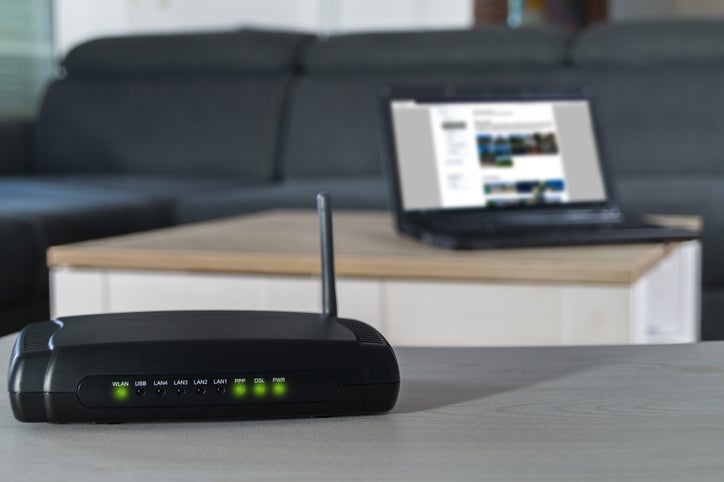What is bandwidth and why is it important for my business?
These days, bandwidth and internet connectivity issues aren’t just a nuisance: they can actually end up costing your business big time. From sending files to sharing your screen on video calls, you need a bandwidth connection that can keep up with your fast-paced business.
But, what exactly is bandwidth and why is it important to have a good connection?
With our handy guide, we’ll help you understand bandwidth — from getting to grips with the differences between internet connections to how to improve your speed — so you can feel confident choosing your business broadband package.
What is bandwidth?
A lot of the time, bandwidth is often mistaken for internet speed. However, this isn’t the case.
Bandwidth is actually the volume of information that can be sent from one connection to another in a set amount of time — which is calculated in Mbps (megabits per second). Bandwidth is an important factor when it comes to determining the quality and speed of a network or internet connection.
Essentially, the higher the bandwidth, the faster and more efficient your internet will be.

Why is bandwidth important?
Bandwidth is important for determining how fast a web page loads on your browser. For that reason, it’s one of the most important things to consider when choosing a platform for your website.
Typically, a website that’s loaded with heavy images and long videos will need a higher bandwidth of 25 Mbps or above. In contrast, websites that consist of bodies of text will comparatively need less.
Just as a fast internet connection will allow you to upload your products quicker, higher bandwidth will effectively improve the quality and user experience of your website.
How to measure bandwidth
When it comes to measuring your bandwidth, there are several factors you should consider:
- Internet usage — The amount of information that is transferred over your internet connection.
- Background usage — The amount of background uploads and downloads that you use will slow your bandwidth down.
- Users on connection — How many users are on a connection will impact the quality and speed of your bandwidth.
Your bandwidth connection can be symmetrical — which means the upload and download data capacity is the same in both directions — or asymmetrical, which means they’re not equal. For an average internet user, download speeds are much more important than upload, as you’re much more likely to to utilise your bandwidth this way.
You can run a bandwidth test with websites like Speedtest.net which is one of the easiest and quickest ways to test the speed and performance of your connection.
Bandwidth speed tests are typically done by combining firmware or software with a network interface. It’ll count the total amount of traffic sent and received across a specific period of time and then the result is then expressed as a per-second number.
Does more bandwidth mean faster internet?
Bandwidth measures how much time it takes to transport data from one point to another, so yes, more bandwidth can increase your internet speeds. High bandwidth generally correlates to faster internet speeds while you might find your internet is sluggish with low bandwidth.
How do I check my internet bandwidth?
You can easily check how your bandwidth is performing by visiting a bandwidth measuring site. The site will conduct checks on how long it takes your internet to upload and download and transport information. You'll get a result at the end of the test and be able to see if your bandwidth is good or bad.
What causes low internet bandwidth?
There are a few things that could affect your bandwidth. One of those factors is too many people using the same internet network or device as you. Another could be the quality of your provider as well as how good your local area is for internet signal.
How much bandwidth does my company need?
Not every online activity in your business will use the same amount of bandwidth.
1. Consider how much bandwidth each employee needs
To make a general estimate of how much bandwidth you’ll need, you’ll first have to gauge your employee’s internet usage. From video editors to product uploaders, no two jobs are the same and neither will be their demand for the internet.
2. Factor in your forecasted business growth
Next, you’ll have to look at your business growth forecast to ensure that your bandwidth can cover any increased usage needs as your business grows throughout the year. With this, calculate how much bandwidth is used daily during the typical peak periods and monitor which apps or programs are using the most.
3. Regularly reset and test
It’s a good idea to regularly test and reset your bandwidth to see a clearer picture. Testing on different days, at different times and under contrasting conditions will give a wider view of how much bandwidth your company uses and needs.
What’s the difference between bandwidth and internet speed?
Bandwidth and internet speeds are both related, however they’re different measurements of connection quality. Bandwidth refers to the maximum amount of data that your connection can handle at any given moment. Speed, however, refers to the maximum rate you can transmit data.
Essentially, both bandwidth and speed need to work seamlessly together to produce a strong, secure and fast internet connection.
What are the different types of internet connections?
There are several different types of internet connections in the UK but they all follow the same rule. A cable runs from the local BT Telephone Exchange to a Cabinet which then directly supplies your business with an internet connection. Usually, these cables run either through an overhead aerial system or underground.
The type of cable that’s used when installing your internet can have an impact on your connection. Over the years, copper cabling has been phased out and replaced with Fibre-Optic cables as it works greater over long distances and has a larger capacity for bandwidth.
Cable internet
Instead of using copper wires, cable broadband used coaxial cables to connect your business to a fibre cabinet in your area. Typically, this usually gives a much faster connection than the traditional copper cable phone lines.
In the UK, only Virgin Media and a few local providers offer this version of cable internet — which can sometimes also be known as Hybrid Fibre-Coaxial Connections.
Fibre-optic internet
More commonly known as fibre internet, fibre-optic broadband is one of the most popular connections in the UK. With a fibre connection, it simply means that fibre cables are used at some point from the connection of the provider to your business.
Not only can fibre cables support very high bandwidth levels to carry more data, but they’re also not as susceptible to some of the more severe weather conditions which mean fewer power outages.
ADSL internet
Asymmetric Digital Subscriber Line, or ADSL for short, is one of the oldest and slowest types of connections in the UK. ADSL can be split into ADSL1 and ADSL2+.
ADSL1
ADSL1’s connection from the Exchange is completely copper and extremely slow. Its typical download speed, at maximum, is 8Mbps.
ADSL2+
ADSL2+ is an upgraded version of ADSL1. It uses the same copper line from the Exchange but has improved technology which allows for faster and higher speeds. Although it can vary depending on the distance, typically its maximum download speed is 24 Mbps.
What is the difference between upload and download speeds?
Download and upload speeds can make a big difference to the day-to-day running of your business. The faster the speeds the more efficient you can work.
Your internet connection has two speeds — learn more about upload and download speeds with our in-depth guide to upload and download speeds.
Download speed refers to the rate that digital data is transferred from the internet to your device — so anything from receiving files, documents, images or music — while upload speed is the rate that any online data is transferred from your device to the internet.
Depending on which type of business you’re in, you’ll be able to tell which speeds will work best for your company.
Make sure to get the speeds you need to keep your business running.
What are some common bandwidth issues?
From online storage to VoIP, businesses are becoming increasingly reliant on the internet for many important systems. While internet speeds may be getting faster, bandwidth hogs still remain one of the most common frustrations in the office.
1. Video calls and VoIP
Communication is a vital aspect of keeping your business afloat and functioning. Chances are, your VoIP system is a major part of running the day-to-day activities in your office and is an important piece of technology.
It’s best to keep your VoIP in a separate space so it won’t share the same resources as your other systems — this way call quality won’t take a hit every time there’s traffic on the network.
Make sure your business can communicate seamlessly with the help of our VoIP phone systems.
Voice calls generally won’t consume a lot of bandwidth, unless you’re running a call centre or recruitment agency. However, as many workplaces have decided to take a hybrid approach of working from home and in the office, video calls between clients and colleagues will take up a large amount of bandwidth.
2. Internet and background usage
As you increase the number of internet tasks and programs you’re running at one single time, the speed of your bandwidth can decrease. This is because the data requirements of your download usage approaches or exceeds the rate of the maximum available bandwidth.
Background usage can also be a big contributor to slow bandwidth. The number of background uploads and downloads that occur on your computer will slow your bandwidth down significantly. This is typically software that automatically updates like system updates and antivirus programs.
You can easily turn off automatic updates in the settings of the individual program.
3. File sharing
A lot of the time, peer-to-peer file sharing will use as much bandwidth as it can get. Sending and downloading large files can wreak havoc on your bandwidth — meaning your connection, on a whole, will suffer.
If any of your employees download illegal or pirated content using your office connection, this can leave your business open to cyber attacks. Learn how to protect your business online with our guide to internet security.
4. Overcrowded connection
When multiple employees are using the same, single connection, more devices will use more bandwidth. Because of this, each device is automatically allotted a smaller portion of available bandwidth which can result in slower data transfer.
How to improve your businesses bandwidth speed
If your business is suffering from bad bandwidth, this can have a severe impact on its daily operations, and in turn, your business as a whole.
Luckily, there are plenty of ways to improve your bandwidth.
1. Upgrade your internet plan
Upgrade your internet plan to a plan with more bandwidth. While you can prioritise parts of your plan by using packet shaping, this will usually not make sure of a difference. The best way to increase your bandwidth is to simply buy more.
2. Clean up your device
Closing background apps, clearing your cache and removing malware are all great ways at cleaning up your device. The idea from this is that it’ll free up more space to provide crucial bandwidth connections.
3. Use a VPN
To avoid bandwidth throttling, use a VPN. This can also hide your IP address and encrypt your traffic, making it difficult to track. This means that Internet Search Provider can’t see what you’re doing online and limit your speed.
4. Limit the number of connected devices
Ideally, limiting the number of devices on your network can be a great way to increase your bandwidth. With fewer people on the connection at one time, this means that your bandwidth won’t be divided up and allocated to each device in a smaller amount.
Get your business bandwidth up to speed with Bionic
To keep your business running smoothly online, it’s crucial that your bandwidth is up to the task. From increasing your bandwidth speeds to knowing the difference between your upload and download speeds, bandwidth can keep your business running.
To find out more about bandwidth or to compare business broadband deals, get in touch with the Bionic team today.








